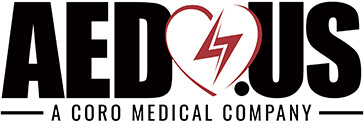Automatic External Defibrillators (AEDs) are used when someone has a sudden cardiac arrest. They’re designed to enable anyone – regardless of medical training – to use them, but rescuers still need to know the correct AED pad placement to deliver effective treatment. This can be an intimidating step in the rescue process for some, so we will cover all the basics.
Keep reading to learn more, including where to place AED pads, why it matters, and common mistakes people make when using AEDs.
Defibrillator Pad Placement: Why Does it Matter?
AEDs work by sending an electrical pulse through the heart muscles to regulate its beating. In order to do this properly, AED pads (electrodes) need to be positioned so the electricity flows properly and targets the correct muscles.
Two Steps for Proper AED Pad Placement
Before we begin, a brief note on left vs. right – We will refer to the patient’s left and right anatomy, which will be the opposite of what it looks like when you’re standing over the victim. With that, follow these steps to ensure proper AED pad placement for adults:
- The first pad goes under the patient’s right collarbone, above the peck.
- The second pad goes on the left chest, under the armpit.
Most AEDs will include both visual and verbal instructions for how to place pads correctly. However, this diagram can be a helpful visual reference to understand where to place AED pads in relation to the heart. Keep in mind that this pad placement is best for adults. When working with children and infants, one pad should be placed in the center of the chest, and the other in the center of the back.
Common Mistakes to Avoid
While you may think AED pad placement for adults seems straightforward, many people have a hard time placing the second pad on the left chest wall. Some rescuers make the mistake of putting it directly on the center of the chest, which can make the shock less effective. Instead, as noted in the diagram above, it needs to be placed off to the side of the chest, below the armpit.
Other issues some rescuers face are clothing, undergarments, or excessive chest hair on victims. All of these can interfere with delivering an effective shock and should be removed before placing the pads. While this may feel uncomfortable, the victim’s life depends on proper electrode function and following AED best practices. Many AEDs come with scissors and/or a razor to make clothing and hair removal more efficient.
Wrapping Up
Mastering the proper defib pad placement and preparing for potential roadblocks will help you focus on administering CPR and delivering a shock to the victim if needed. The AED should guide you through these steps until professional help arrives. If you have any additional questions about pad placement, choosing an AED, or anything else, our team of customer service experts is available to help.
Sources
- American Red Cross. “AED Steps.” https://www.redcross.org/. 11 August 2021.
 Written by Blaire Czarniecki
Written by Blaire Czarniecki
Customer Service Director
Blaire attended the University of Tennessee where she graduated with a Bachelor of Science in Human Ecology- Child and Family Studies. She has been in the Automated External Defibrillator (AED) industry for over eight years and is the Director of Customer Service for Coro Medical. Blaire is also an American Red Cross-certified CPR/AED/First Aid Instructor, highly trained by each manufacturer on their specific AEDs, and knowledgeable regarding ALL State AED regulations and legislation.“I know that every day I come to work, I am playing a part in saving someone’s life. I am passionate about these devices and am always looking for new and innovative ways to spread awareness and knowledge about Sudden Cardiac Arrest (SCA). I look forward to the day when everywhere I go, I will see an AED—when SCA will no longer take any lives.”
Last updated September 14th, 2021.





